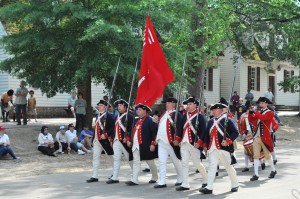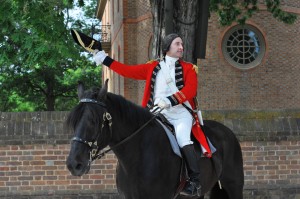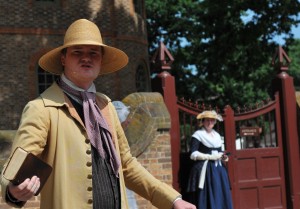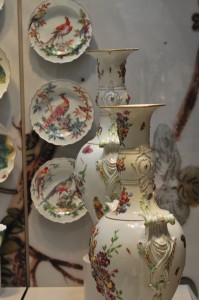 Despite living in the Virginia-Maryland area for the past 10 years, we had never been to Colonial Williamsburg, eschewing it as a tourist trap. Along with Ashu & Shweta, we drove down to confirm our notion. We were correct. It is indeed a tourist trap but we also learnt that there is no reason why we cannot enjoy a tourist trap. We started off early morning after breakfasting on zuchhini muffins and had a really peaceful drive to the humungous visitor center at Colonial Williamsburg.  After purchasing our tickets,  a shuttle bus dropped us off near the Governor’s Palace.
Despite living in the Virginia-Maryland area for the past 10 years, we had never been to Colonial Williamsburg, eschewing it as a tourist trap. Along with Ashu & Shweta, we drove down to confirm our notion. We were correct. It is indeed a tourist trap but we also learnt that there is no reason why we cannot enjoy a tourist trap. We started off early morning after breakfasting on zuchhini muffins and had a really peaceful drive to the humungous visitor center at Colonial Williamsburg.  After purchasing our tickets,  a shuttle bus dropped us off near the Governor’s Palace.
The town of Colonial Williamsburg was recreated to portray the city of Williamsburg, VA as it was in pre-American Independence days, from about 1700 onwards. This area with neighbouring Jamestown was one of the earliest permanent settlements for immigrants from England in US. Â Most of the houses that flank the Main Street (Duke of Gloucester Street), were rebuilt or restored at their original sites, thus lending the town a degree of authenticity.
The Governor’s palace was superbly maintained, atleast from what we could see from the outside. A lady, in eighteenth century costume, guided us to the flower garden to one side of the palace It was a riot of colors, with foxgloves of many shades and we stopped to take several photographs.  Behind the palace was a kitchen garden and a “working†kitchen. There was a cook in the kitchen who seemed to have just put a kettle on the stove.
palace It was a riot of colors, with foxgloves of many shades and we stopped to take several photographs.  Behind the palace was a kitchen garden and a “working†kitchen. There was a cook in the kitchen who seemed to have just put a kettle on the stove.
We made our way to the main street by cutting across the long green lawns in front of the palace. Kids were trying to roll the hoop— and Ashu was remembering his childhood days where he used to roll a punctured cycle tire. The Duke of Gloucester Street is flanked on both sides with several business establishments, as it would have been in the 18th century. We passed a courthouse where a volunteer informed us how the judicial system worked. There was a pillory nearby—there were no jails in those days – you were either fined money or hanged for your crimes. There was a milliner’s shop, a gunsmith, a blacksmith, a wig-maker, bakery and even a couple of taverns. We stopped for lunch at one of these taverns where a waitress apologized for serving us inferior chicken stew instead of possum or squirrel. She also offered to take any trinkets in lieu of money at the end of my lunch (excellent corn chowder with breadsticks).
 Folks in costume were walking to & fro, sometimes joined by a soldier on a horse or a farmer with a bullock cart. The final event of the day was the re-enactment  of a few scenes from the American war of independence. The first scene was the reading of the “Declaration of Independence†to the townfolks as the American soldiers marched down the street. This was followed by another scene where a young soldier celebrated Benedict Arnold’s victory over the British at Saratoga and exhorted the locals to stop thinking of themselves as “English†and consider the French as their allies in the struggle for independence.
Folks in costume were walking to & fro, sometimes joined by a soldier on a horse or a farmer with a bullock cart. The final event of the day was the re-enactment  of a few scenes from the American war of independence. The first scene was the reading of the “Declaration of Independence†to the townfolks as the American soldiers marched down the street. This was followed by another scene where a young soldier celebrated Benedict Arnold’s victory over the British at Saratoga and exhorted the locals to stop thinking of themselves as “English†and consider the French as their allies in the struggle for independence.
The third scene, by far the best of the lot, was after Benedict Arnold defected to the British side and attempts to convince the locals of Williamsburg to support the British. He made a long speech which was rational and responded quite calmly to heckles from the crowd that booed him as a traitor.
Williamsburg to support the British. He made a long speech which was rational and responded quite calmly to heckles from the crowd that booed him as a traitor.
The next scene was when a African American pastor explained to his flock why the separation of church and state was a good idea freeing the African Americans to worship how and when they wish to. Â Â The final scene was the victory celebration as George Washington and his troops emerge victorious in the battle and march into the city.
 In many cases the same actors played different roles but it was kind of nice to see a slice of history in action. Our final stop on the tour was the local museum – which turned out to be a wonderful surprise. All four of us were impressed by the museum although completely different exhibits caught our fancy. Ashu enjoyed the American photographs, Shweta liked the stone ware, Seejo voted for the ceramic ware while I thought that the collection of quilts was pretty neat.
In many cases the same actors played different roles but it was kind of nice to see a slice of history in action. Our final stop on the tour was the local museum – which turned out to be a wonderful surprise. All four of us were impressed by the museum although completely different exhibits caught our fancy. Ashu enjoyed the American photographs, Shweta liked the stone ware, Seejo voted for the ceramic ware while I thought that the collection of quilts was pretty neat.
All in all, it was a nice day trip. The re-enactment was indeed a great way to make history alive.  One thing, I liked is that the story of Benedict Arnold was represented from his own point of view rather than merely labeling him a traitor. I also liked how they depicted the locals viewpoint of  changing from an Englishman (as they have always considered themselves)  to the new young American (as aligned with political interests)

Nice read … 🙂